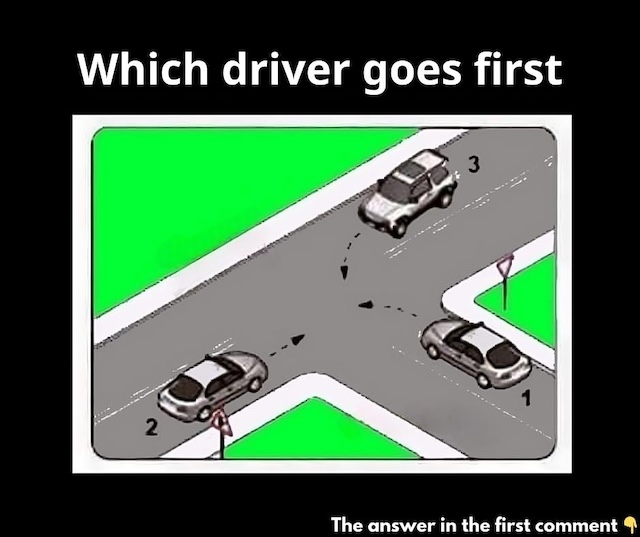How well do you know your traffic rules? Here’s a brain teaser that’s been stumping even the most experienced drivers—and only 5% of people get the correct answer on the first try. Picture this: three cars are approaching an intersection, each coming from a different direction. The question is simple on the surface—who goes first?

But the answer isn’t as straightforward as you might think. Small but important details like yield signs and the right-hand rule can completely change the outcome, and most people miss them. In this puzzle, the goal is to identify the correct sequence in which the cars should proceed through the intersection. Before jumping to a conclusion, you’ll need to think carefully and analyze the situation step by step. Let’s dive into this challenge and test just how well you understand driving logic and right-of-way rules. First, let’s take a look at the basic setup of the intersection. Car 1, Car 2, and Car 3 are all approaching from different directions.
At first glance, their positions may lead you to think that whoever arrives first should go, but in reality, it’s not about arrival—it’s about rules. That’s where most people go wrong. They make assumptions without examining the signs or recalling essential traffic principles. One of the first common mistakes people make with this riddle is ignoring traffic signs. They often focus solely on the cars and their relative positions, overlooking the fact that yield signs and road markings dictate right-of-way in these scenarios. Another frequent oversight is forgetting the right-hand rule, a basic but often underused rule in driving situations where no traffic lights or stop signs are present. And finally, a lot of people rush to answer, thinking it’s just a simple guessing game, when in reality, a careful step-by-step breakdown reveals the answer logically and clearly. Let’s walk through the solution.
Step one is to evaluate the traffic signs. The key detail in the image is that both Car 1 and Car 3 are facing yield signs. Car 2, on the other hand, is on the priority road, which is indicated by the triangular yield signs facing the other two cars. According to standard traffic regulations, vehicles on the priority road have the right of way over those that are required to yield. Therefore, Car 2 is the first vehicle to proceed through the intersection. Step two involves deciding which car goes next. Once Car 2 has cleared the intersection, we’re left with Cars 1 and 3, both of which are still at yield signs. This is where the right-hand rule becomes relevant. When two vehicles are at equal priority and no additional signs provide guidance, the car on the right has the advantage.
In this case, Car 3 is on the right-hand side of Car 1, which means Car 3 proceeds next. Finally, with Cars 2 and 3 having cleared the intersection, Car 1 is the only one remaining. Since there are no other vehicles to yield to, Car 1 is now free to go. Putting it all together, the correct order of movement is: Car 2 goes first, followed by Car 3, and finally Car 1. So the proper driving sequence at this intersection is 2–3–1. It may seem confusing at first, but when you break it down using traffic laws and logic, the answer becomes crystal clear. Did you figure it out correctly? If so, congratulations—you’re in the top 5% who can interpret and apply traffic rules accurately in a tricky situation. If not, don’t worry—these kinds of puzzles are meant to challenge your thinking and help sharpen your observation skills.

Understanding the logic behind them can improve your problem-solving ability not just in traffic, but in everyday life. So the next time you find yourself at an intersection—real or hypothetical—take a moment to observe the signs, think through the rules, and proceed with confidence. And if you enjoyed this puzzle, be sure to share it with your friends and family to see if they can get the correct answer, too. Who knows—you might just spark a fun debate and help others learn something new about the rules of the road.





